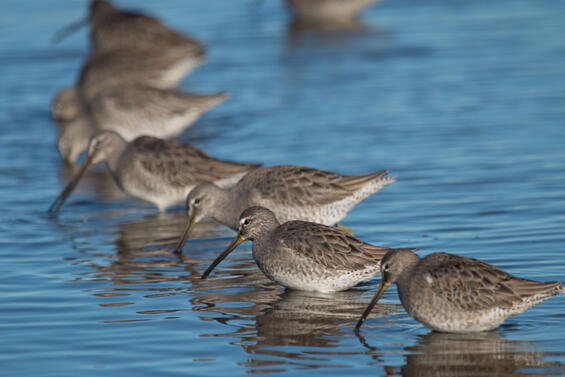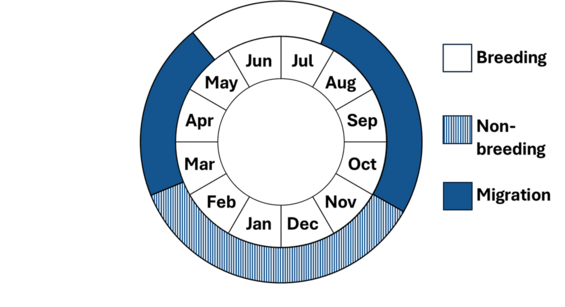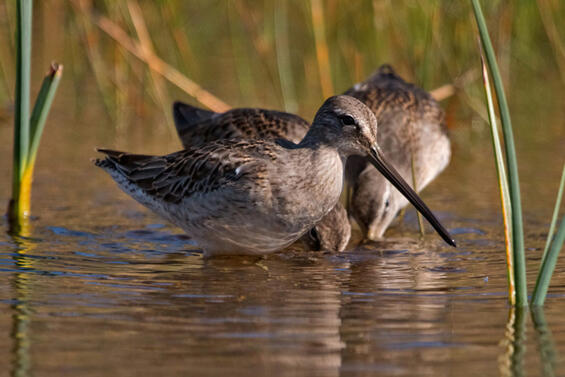- Scientific name: Limnodromus griseus
Species of Greatest Conservation Need (MA State Wildlife Action Plan)
Description

A flock of short-billed dowitchers use their long bills to forage for invertebrates beneath the surface.
A medium-sized shorebird, the short-billed dowitcher is 25–29 cm (9.8-11.4 in) long with a 45–51 cm (17.7-20.1 in) wingspan and a mass of 90–120 g (3.2-4.2 oz). Despite their name, short-billed dowitchers have a with a very long, straight bill. They have a rusty breast in spring and summer, and a gray breast and back in fall. Short-billed dowitchers feed with a "sewing machine" motion. Its voice is a staccato tu-tu-tu. This species is very difficult to separate from the long-billed dowitcher (Limnodromus scolopaceus), which averages a slightly longer bill and is much less commonly found in Massachusetts.
Life cycle and behavior
Short-billed dowitchers are a long-distance migrant. They leave their wintering grounds from March to May and arrive on their breeding grounds from mid-May to early June. They raise one brood per breeding season and have a clutch size of four eggs. Both adults incubate nests for about 21 days. Chicks are precocial, can walk immediately after hatch, and can swim as soon as they are dry. Parents lead their chicks to feeding areas and alert chicks to potential predators. Broods are usually seen in wetland habitat. Female parents usually depart nest either right before or within several days of hatching and begin migrating south. Males stay until the chicks are capable of flight. Adults begin migrating before juveniles and are present at migratory sites from end of June to mid-July. Juvenile migration peaks in August and early September and continues in lower numbers into October. Age at first breeding for this is species is unknown, and the longest documented individual is 13 years.
Breeding season diets consists of aquatic and terrestrial invertebrates and sometimes seeds. Non-breeding diets are aquatic invertebrates. Short-billed dowitchers probe into substrates and may submerge their head to feed in deeper water.

Population status
Population size is unknown and difficult to estimate, as their wintering range overlaps with long-billed dowitchers. Current population estimates are 150,000–245,000 mature individuals. Data indicate a population decline, but the severity is unknown.
Short-billed dowitchers were historically an abundant and a prized game bird across North America. Unregulated hunting continues on the nonbreeding grounds.

Short-billed dowitcher (Limnodromus griseus)
Distribution and abundance
Short-billed dowitchers are found only in North and South America. They breed in Canada and southern Alaska and winter coastally in Central and South America as well as California, the Gulf Coast, and from Florida to Virginia on the east coast.
Short-billed dowitchers occur in Massachusetts as a migrant during both spring and late summer-early fall.
Habitat
Breeding habitats include sedge meadows, black-spruce bogs, muskegs, and wet sedge marshes. During migration, short-billed dowitchers prefer saltwater habitats and are common on tidal flats, beaches, salt marshes, sewage ponds, and flooded fields. On winter grounds, they inhabit coastal mud flats, brackish lagoons, mangrove coasts, and salt and shrimp ponds.
Short-billed dowitchers in Massachusetts occur primarily on extensive coastal mudflats and sandflats. Occasionally, a few birds occur at inland locations on mudflats in marshes or reservoirs.
Healthy habitats are vital for supporting native wildlife and plants. Explore habitats and learn about conservation and restoration in Massachusetts.
Threats
Threats to short-billed dowitchers throughout their range include habitat loss and anthropogenic disturbance. Short-billed dowitcher habitat is relatively secure in Massachusetts, but it could be degraded by oil spills or loss of mudflats to dredging or coastal development. Unregulated hunting throughout large portions of the nonbreeding grounds continues to be a potential population-level threat. Human disturbance in feeding or roosting habitat may be a threat at some locations.
Plastic trash in the environment poses a threat as it can be mistaken as food by seabirds and shorebirds and ingested or cause entanglement. Ingested plastics, common for seabirds, can block digestive tracts, cause internal injuries, disrupt the endocrine system, and lead to death. Entanglement from fishing gear and other string-like plastics can cause mortality by strangulation and impairing movements.
Conservation
Current research needs are to identify the apparent Atlantic coast decline as well as possible causes, if verified. MassWildlife’s Natural Heritage Endangered Species Program (NHESP) does not track occurrences of short-billed dowitchers in Massachusetts. Avoid or recycle single-use plastics and promote and participate in beach cleanup efforts.
References
BirdLife International. Species factsheet: short-billed dowitcher Limnodromus griseus. 2024. https://datazone.birdlife.org/species/factsheet/short-billed-dowitcher-limnodromus-griseus
Jehl Jr., J. R., J. Klima, and R. E. Harris. Short-billed dowitcher (Limnodromus griseus), version 1.0. In Birds of the World (A. F. Poole and F. B. Gill, Editors). 2020. Cornell Lab of Ornithology, Ithaca, NY, USA. https://doi-org.silk.library.umass.edu/10.2173/bow.shbdow.01
Petersen, W.R., and W.R. Meservey. Massachusetts Breeding Bird Atlas. 2003. Massachusetts Audubon Society and University of Massachusetts Press, Amherst, Massachusetts.
Veit, R., and W.R. Petersen. Birds of Massachusetts. 1993. Massachusetts Audubon Society, Lincoln, Massachusetts.
Contact
| Date published: | May 15, 2025 |
|---|